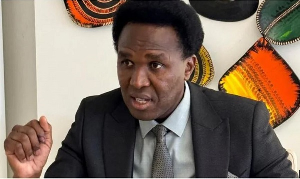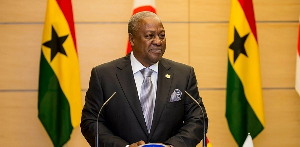Feature by G.B. Osei-Antwi
As part of Tema Oil Refinery (TOR) expansion and modernisation programme in 1997, the Crude Distillation Unit (CDU) was revamped from 28,000 BPSD to 45,000 in 2002. In addition, a 14,000 capacity Residue Fluid Catalytic Cracking (RFCC) unit was constructed and commissioned to convert the low value residue from CDU into high value products - namely gasoline, liquefied petroleum gas (LPG) and diesel.
Before the expansion programme, TOR assets were valued at 383 million dollars by the consortium of insurance companies. The second phase of the expansion and modernisation shot the assets value of TOR to 652 million dollars, and this increased the company's insurance premium to 6.55 million dollars, which was paid in 2003.
Before the end of every year, risk management survey is carried out by the insurance companies to find out weather TOR is high or low risk, and based on the survey, the insurance premium to be paid is calculated by the consortium of insurance companies.
Dr Kofi Kodua Sarpong, Deputy Chief Executive Officer (CEO) of TOR in charge of Finance and Commerce, told the Ghana news Agency that TOR Management go all out to tackle the recommendations of risk factors coupled with aggressive works that have been recommended.
Therefore, before the end of the year, the Management met with re-insurers in the United Kingdom (UK), put before them what the Company had been able to achieve in good work ethics, supported with documents, what it is still doing and what it intends to do to reduce risks. Following the assessment of the re-insurers, the insurance premium is reduced, maintained or raised.
Dr Sarpong said for exhibiting good management practices to tackle the risk factors before the end of last year, TOR and for that matter the nation benefited from a reduction of 1.3 million dollars of the company's insurance premium for 2004.
The assets value of TOR for 2003 and 2004 have been pegged at 652 million dollars, and while 6.55 million dollars was paid in the pervious year, that of this year has been reduced by 16 per cent to 5.5 million dollars whose equivalent is 12 billion cedis.
To achieve this reduction in insurance premium, TOR engaged the services of K.E.K. Insurance Brokers, who acted as their consultants and in the words of Dr Sarpong, "they integrated risk management, acted as our policemen and ensured that what had been planned to avoid any high risk at the refinery, was really achieved.
For example, we were directed to install a control valve, otherwise known as Emergency Isolation Valve (EIV), which helps to cut off fire connected to the pipelines. The pipelines are checked and maintained at periodic intervals. At the jetty, TOR has improved fire fighting, and the management of all these are still on going. Management is also committed to improving on the safety at the plant.
Dr Sarpong said the essence of reducing risk is to protect the assets of the Company. "Therefore, as a refinery, we have to pay a calculated amount of our assets as premium to insure the plant, so that when there happens to be an accident (of say fire), the insurance company will pay for the cost of the accident."
He stressed that the cost of getting that protection is the insurance premium that is paid.
Dr Sarpong said K.E.K. Insurance Brokers came out with a number of recommendations, held series of meetings with the Management to discuss what should be done to improve safety at the Refinery, and since they complied with their suggestions, the result led to the reduction of 16 per cent insurance premium for 2004.
For a long-term, using TOR's corporate plan, TOR hopes to achieve further reduction through the advice of the Consultants.
TOR has other insurance policies including motor vehicle insurance, group life insurance policy, marine insurance and fire insurance. TOR has now opened tender for other insurance, and the aim is to drive down the cost of insurance, to add up to the savings that have been made on insurance this year.
The Refinery paid insurance premium of 745,000 dollars in 1999; 887,000 dollars in 2000 and 1.08 million dollars in 2001. From the latter part of 2002 the premium rose to 3.2 million dollars when the RFCC was about to be completed and to 6.55 million dollars in 2003 when the RFCC was fully operational.
Dr Sarpong explained that the consortium of insurance companies, 34 from outside and nine in the country had to increase the premium between 2002 and 2003 because of the RFCC which added up to the assets of TOR.
He said house keeping at TOR was not the best so Global Political Risk that finds out risk factors in countries and industry, therefore, classified TOR in category "D".
The TOR Management and Board of Directors should be congratulated for beginning the year on good note with a profit of 12 billion cedis. At least the savings made would go to reduce some of the financial losses and pep up the image of the Refinery. Let's give credit where it is due and say: "Bravo1! Let's see more of these."
Click to view details



Business News of Thursday, 29 January 2004
Source: GNA
















